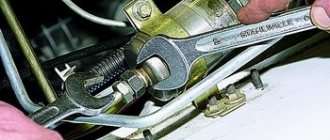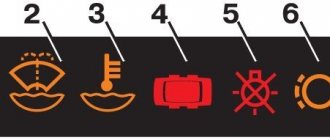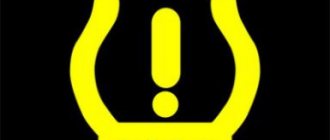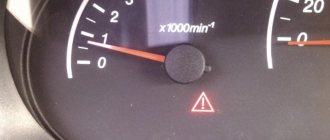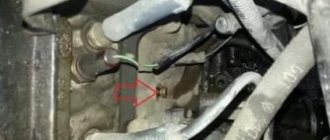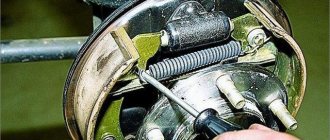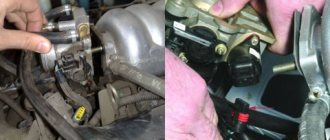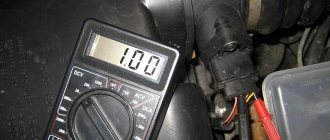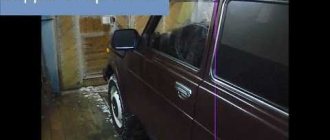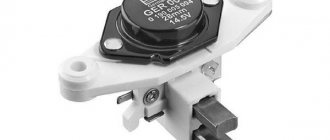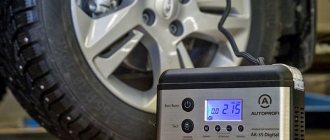New Niva.. The check light came on at 60 km.
New Niva.. The check light came on at 60 km.
Post by flatraaa » 04 Feb 2013, 22:50
Re: New Niva.. The check light came on at 60 km
Post by Warlock » 04 Feb 2013, 23:01
Re: New Niva.. The check light came on at 60 km
Post by flatraaa » 04 Feb 2013, 23:40
Re: New Niva.. The check light came on at 60 km
Post by Warlock » 04 Feb 2013, 23:49
Re: New Niva.. The check light came on at 60 km
Post by flatraaa » 05 Feb 2013, 00:00
Re: New Niva.. The check light came on at 60 km
Post by Warlock » 05 Feb 2013, 00:09
Re: New Niva.. The check light came on at 60 km
Post by ParaLanik » 05 Feb 2013, 00:22
Re: New Niva.. The check light came on at 60 km
Post by Sunny » 05 Feb 2013, 07:23
Re: New Niva.. The check light came on at 60 km
Post by Sash » 05 Feb 2013, 11:07
Re: New Niva.. The check light came on at 60 km
Post by Sunny » 05 Feb 2013, 12:13
Re: New Niva.. The check light came on at 60 km
Post by Sash » 05 Feb 2013, 15:43
Re: New Niva.. The check light came on at 60 km
Post by flatraaa » 05 Feb 2013, 19:49
Re: New Niva.. The check light came on at 60 km
Post by flatraaa » 05 Feb 2013, 19:54
Re: New Niva.. The check light came on at 60 km
Post by Valkin » 05 Feb 2013, 20:54
Re: New Niva.. The check light came on at 60 km
Post by Warlock » 05 Feb 2013, 21:00
Re: New Niva.. The check light came on at 60 km
Post by Warlock » 05 Feb 2013, 21:07
Re: New Niva.. The check light came on at 60 km
Post by Valkin » 05 Feb 2013, 21:15
Re: New Niva.. The check light came on at 60 km
Post by flatraaa » 05 Feb 2013, 21:49
Re: New Niva.. The check light came on at 60 km
Post by boczman » 05 Feb 2013, 22:18
Re: New Niva.. The check light came on at 60 km
Post by Warlock » 05 Feb 2013, 22:57
What does the Check Engine light mean?
When the Check Engine light, located on the dashboard, comes on, it means that the electronic control unit (ECU) has detected a problem with one of the vehicle's systems.
Reference. The light comes on when the engine starts and then goes off. It is at this time that the ECU tests the main systems of the car, and if it finds no problems, it turns off the emergency indicator.
If the ECU detects a malfunction, it records it in the internal memory in the form of a special error code and informs the driver with a lit “check”. In some cases, the indicator may be constantly on, in others it may go out and then light up again - it all depends on the specific type of malfunction.
A light coming on does not mean that you should necessarily stop the car and turn off the engine. Check Engine can be triggered in different cases, so you need to react to it differently :
- Problems with the Check Engine light coming on can be caused by objective reasons. For example, it is triggered by the installation of a new alarm system or an almost discharged battery. In this case, you can ignore the error.
- If the check light is on on the Chevrolet Niva, but the engine is running normally, you can continue driving. Such a malfunction, as a rule, is not critical. However, subsequently you need to diagnose the error using a scanner or computer and troubleshoot the problem.
- If the warning light goes off simultaneously with a sharp change in the behavior of the Niva, it is recommended to immediately stop the car and turn off the engine. A sharp drop in power, tripping, the appearance of strong detonations at idle, floating speed while driving may indicate a serious engine malfunction. It is dangerous to continue driving in such a situation.
Why is error 8 associated with brake system problems?
Some car enthusiasts misinterpret error message 8, believing that they need to check the brake system. This is due to the fact that on VAZ cars this fault number indicates insufficient brake fluid level.
The Chevrolet Niva's on-board computer uses different designations, so you should not interpret them in the same way as in the VAZ. If you doubt the condition of the brake system, you can check it during the repair process. First of all, pay attention to the brake fluid level, and then check the pads.
Why did the light come on and how to fix it
There are many reasons for the Check Engine light to come on . The most common reasons for a light bulb to go off include the following problems.
Refueling with low-quality fuel
Most often, the indicator light comes on after filling the gas tank with low-quality gasoline . In this case, you can correct the situation by adding high-quality fuel to the tank. You can also completely drain the gasoline, clean the fuel system, and then refuel with high-quality fuel at a reliable gas station.
Refueling with 92 gasoline
The recommended gasoline for the Chevrolet Niva engine has an octane number of 95 , but the Chevy Niva engine is capable of “digesting” 92-octane gasoline. In this case, the Check Engine warning light may be triggered, since due to insufficient octane number of gasoline, the level of fuel detonation in the engine cylinders increases. Switching to 95 gasoline helps solve the problem.
Low battery
The light may light up if the on-board network voltage is low , that is, the battery is almost discharged. If the car engine starts, then the activation of the indicator does not have any negative consequences. You just need to charge the battery, after which the problem will disappear.
Insufficient engine oil level
Lack of oil causes engine oil starvation . The low level should also be indicated by the oil pressure warning light located on the instrument panel. But sometimes it doesn’t work, and the problem only manifests itself in the Check Engine light coming on. You need to check the oil level, and it is also worth inspecting the engine compartment for leaks. If the level is insufficient, add engine oil to the filler neck.
Engine overheating
It may be due to a malfunction of the radiator cooling fan, a coolant leak, or other reasons. This malfunction is easily diagnosed, since the engine temperature is displayed on the Chevy Niva dashboard. To solve the problem, you need to stop and let the engine cool. Then you should diagnose and eliminate the malfunction that caused the light bulb to blink.
Contamination of fuel injectors with tar deposits
For this reason, the pressure in the fuel line decreases . It manifests itself in complications when starting the engine, increased fuel consumption, failures during acceleration, and unstable operation of the engine at idle due to misfires in the engine cylinders. To correct the situation, you need to clean the fuel injectors.
Malfunction of the oxygen sensor (lambda probe)
A breakdown of the oxygen sensor causes the ECU to receive incorrect data . To solve the problem you need to replace the sensor.
Short circuits in the network of other sensors
Low or high sensor signal level . The modern Chevrolet Niva is equipped with a variety of controllers responsible for the stable operation of the engine and other vehicle systems (mass air flow sensor, air flow sensor, air pressure sensor, speed sensor, etc.). Failure of the sensors or short circuit in the electrical wiring causes the Check Engine indicator to light up. To correct the situation, it is necessary to replace the failed controller.
Diagnostics of Niva Chevrolet
The Chevrolet Niva diagnostic connector helps you obtain information about how most units work, into which special equipment is connected via Bluetooth or a cable. Therefore, if you want to conduct independent diagnostics, it is important to know where it is.
The connector in the Niva is located under the steering wheel on the right side, and the pinout itself is under the dashboard on the driver’s side. To check the on-board computer, you need to use special equipment that transmits all the necessary information to the laptop. Data transfer is carried out using a COM port into which a K-LINE type connector is installed.
When connecting, errors may appear on the laptop screen. At this moment, there is no need to worry, since the appearance of such messages may be due to a lack of communication with the device itself. You should also check whether the standard anti-theft system is installed; if so, check the adapter itself. If there is a standard location, then it is connected to the diagnostic line between the ECU and the immobilizer. And if it is missing, a plug is installed in its place. To restore communication between the contacts, a jumper is installed, as shown in the picture below:
Depending on the year of manufacture of the model, the connectors may differ from each other.
- 1 Self-diagnosis
- 2 Check engine error
- 3 Chip tuning
- 4 Summary
Self-diagnosis
If it is not possible to check with a special device, then this can be done using self-diagnosis, which will help to quickly identify all problems associated with the operation of the car. To do this, press the odometer button and turn on the ignition. The speedometer needle will begin to rise to the top; by pressing again, information about the firmware will appear on the screen, and by pressing again, all existing errors will appear.
Let's take a closer look at the Chevrolet Niva error codes with decoding:
During self-diagnosis, error 8 and error 14 often appear, the first informs about problems in the brake system, and the second is related to fuel consumption, quite often this is a system glitch, but in any case you need to replace the sensor responsible for these mechanisms, or reset the memory by resetting the battery terminals.
As practice shows, knowing how to perform an independent check is very useful, since this knowledge helps to quickly identify a malfunction and eliminate it in a timely manner.
Check engine error
If a check light comes on on a Niva Chevrolet car, this warns that there are malfunctions associated with the operation of the engine. The light comes on at the moment when the engine begins to detect a failure or error and writes a specific code into its memory.
Let's look at the main reasons why this warning may appear:
- The air/fuel mixture is incorrect. This problem is eliminated by filling the tank with higher quality gasoline.
- Low engine oil level
- Engine overheated
- There are problems with the ignition system, which may be due to a faulty spark plug or ignition coil
- The power system is faulty. It is possible that fuel injection into one of the cylinders has stopped.
- Lambda probe faulty
- A separate sensor in the ECM system has failed
We can conclude that in some cases, when the engine starts and the check light is on, this may indicate that the engine is operating in emergency mode and the problem is not very critical. If the engine starts and stalls, then this is most likely a problem with the fuel supply or the crankshaft sensor has failed.
In any case, it is better not to use the car until you find out the exact reason.
Chip tuning
Some drivers do chip tuning of the Chevrolet Niva in order to increase engine power. The essence of this procedure is to remove the established restrictions by adjusting the optimal factory settings in the electronic control unit. This procedure helps to extract the additional performance inherent in the motor.
The whole process can be divided into several stages:
- Reading the necessary data from the electronic control unit
- Making the necessary adjustments
- Updating and recording new data
The main advantage of this procedure is:
- Engine power increases
- Speed limit removed
- You can change the fuel type
- All factory settings can be returned at any time
The disadvantages include:
- High cost of work
- The ECU may fail
- Increases fuel consumption, reduces system life
- Errors may appear
Each specialist has a different attitude towards chip tuning, some consider it useful, while others think that this procedure can negatively affect the performance of the car, while reducing its service life.
Bottom line
To summarize, we can conclude that you can identify error codes on a Chevrolet Niva either independently or using a special device. If malfunctions occur, they must be eliminated as soon as possible, otherwise this may lead to irreversible negative consequences in the operation of the entire system.
Source: https://djeeprus.ru/shevrole-niva/elektrooborudovanie/diagnostika-nivy-shevrole
Resetting or Resetting the Check Engine Light
The indicator indicates that the ECU has detected an error and written its code to the internal memory . Therefore, even after the fault has been eliminated, the indicator remains on, since the error was not diagnosed and reset.
The easiest way to reset the error is to disconnect the battery terminal , thereby de-energizing the on-board network. In this case, the light will go out.
For this it is necessary:
- turn off the engine;
- open the hood;
- disconnect the positive terminal of the battery;
- wait a couple of minutes and then reconnect the terminal.
This method will not solve the problem that caused the indicator to light up . If the problem is not resolved, then there is a high probability that after some time the lamp will light up again. Therefore, it is better to diagnose the error code using a scanner and software installed on a computer, laptop or regular smartphone. This can be done at any service station; the procedure will cost from 500 to 1000 rubles. But you can do it on your own.
The Chevrolet Niva, like other modern cars, is equipped with an OBD2 diagnostic connector (16 pin). The connector is located next to the ignition switch and is partially covered by the steering column cover. By connecting a diagnostic scanner connected to a laptop or mobile phone to the connector, you can read all the errors recorded by the electronic control unit.
Important! After the error is read and decrypted, the control indicator should go out.
Chevrolet Niva error codes: decoding and description of meanings
The popular Russian-made model is very widespread in the CIS countries due to its optimal cost and increased cross-country ability, which is critically important in the conditions of domestic operation. Motorists buy cars for off-road travel and small towns, where the quality of roads leaves much to be desired.
The disadvantages of the car include weak wiring - when the load increases to the design limit, on-board electronic systems often fail, which causes software failures. Chevy Niva error codes appear on the dashboard display or are detected using special equipment, but the common thing is that they all indicate a malfunction of a specific component.
Chevrolet Niva error diagnosis
The most reliable way to identify what is wrong with a car is to diagnose electrical appliances and equipment. The procedure allows you to accurately identify breakdowns and quickly repair your car.
There are two ways to detect a problem in a car.
Self-diagnosis VAZ 2123
The simplest procedure allows the motorist to independently identify the damaged area and repair the damage. Thanks to the successful firmware of the on-board computer, some errors are displayed on the standard display. In this case, nothing happens on its own - you will need to perform several steps manually:
- turn off the engine and turn off the ignition;
- find the daily mileage reset button on the dashboard and press it;
- at the same time turn the key in the starting cylinder;
- if everything is done correctly, all the indicators on the dashboard will light up, and the instrument arrows will make a full circle and return to their place;
- at the same time, the firmware version of the on-board computer will be reflected on the built-in display;
- The next press of the key will display a network error.
If the manipulations are correct, one of the indicated codes will appear on the display, and each Niva Chevrolet error number will be responsible for its own section of the highway:
- 0 – error 0 Niva Chevrolet indicates that there are no problems in the on-board circuits; most likely, the breakdown is purely mechanical in nature;
- 1 – standard error of the Niva Chevrolet ECU – the processor is not working correctly;
- 2 – for a Chevrolet Niva, error 2 indicates a lack of power to the gas tank float;
- 4 – malfunction of the battery or generator; a critical excess of the rated voltage of more than 16 volts was detected in the on-board circuits;
- 8 – has the opposite meaning; on a Chevrolet Niva, error 8 indicates an excessive voltage drop in the wiring due to a deep discharge of the battery or a malfunction of the generator;
- 12 – error 12 Chevrolet Niva reports a breakdown of the control indicator;
- 13 – signal transmission from the lambda probe is disrupted, you need to check the device and main power lines;
- 14 – on Niva Chevrolet, error 14 indicates a critical antifreeze temperature, the system requires cooling, otherwise the power unit may boil;
- 15 – the motor is too cold for normal operation, usually the error disappears after a good warm-up or replacement of the sensor;
- 19 – malfunction of the DPKV, the encoding indicates an incorrect speed of rotation of the unit;
- 21/22 – the throttle position differs from the calculated values up/down;
- 23/25 – the air mixture on the intake manifold is excessively cooled or overheated;
- 24 – open circuit of the speedometer, accompanied by a lack of response of the instrument needle to the driver’s manipulations;
- 27/28 – incorrect display of the actual amount of exhaust from the calculated value;
- 33/34 – Mass air flow sensor, the indicators of the device are overestimated or underestimated, relative to the actual state of the system;
- 35 – incorrect operation of the engine at idle, you need to check the correctness of the mixture formation settings;
- 41 – the phase distribution sensor or DPRV has detected an open circuit or the data received is erroneous;
- 42 – multiple misfires were detected, the system turned off the fuel supply to the damaged cylinders;
- 43 – the detonation channel sensor generates an error;
- 44/45 – fuel mixture is too rich/lean; you need to check the fuel lines for mechanical damage;
- 49 – the vacuum gauge is out of order or overloaded;
- 51 – ROM has failed, or there is a breakdown in the power cables;
- 52 – RAM is not working correctly, damaged, no power;
- 53 – the adsorber purge valve is faulty;
- 54 – octane corrector controller is de-energized or broken;
- 55 – the calculated load on the internal combustion engine differs from the established one;
- 61 – the oxygen quantity controller in the intake system transmits incorrect data to the computer.
At the same time, you need to accurately understand that, for example, when error 10 is on the display, the Chevrolet Niva tells the driver that there are several problems (standard, unambiguous codes are summed up).
You should also know that Niva Chevrolet self-diagnosis errors do not reflect the exact location of the breakdown. Codings can only show the section of the wiring where you need to look for the cause of the malfunction. Also, these encryptions may be the result of a software failure after an unsuccessful wash or disconnection of the battery. To obtain more accurate data, the user needs to connect a special diagnostic scanner.
Diagnostics using third-party equipment
More precisely, errors on Chevy Niva can be identified by connecting additional equipment. The technique is more technically complex, but allows us to determine the cause of a breakdown or failure with minimal error. In this case, the sequence of actions is as follows:
- turn off the engine;
- find the contact connector under the dashboard, the connector is located at the bottom of the steering column;
- connect the configured computer to the ECU output;
- turn on the ignition;
- follow the program instructions.
If all actions are performed correctly, all available information and any errors in the form of encrypted codes will be displayed in the desktop window.
There are also specialized scanners designed specifically for Chevrolet NIVA. Dealer devices are connected to the place of the standard signaling unit through an output cable.
Separately, we should highlight modern devices designed to connect a smartphone to a car, while reading encodings and controlling operating modes occurs directly from the gadget’s display.
At the same time, you should know what the encodings displayed during diagnostics mean. The code consists of several elements.
First part:
- P – the motor electronics have failed;
- C – there are problems with the chassis;
- B – interior space, a problem has been detected;
- U – there are problems when establishing pairing of on-board systems.
The next element is a single digit:
- 0 – OBD 2;
- 1-2 – standard code of the manufacturer;
- 3 – reserve part of electrical equipment.
The following digit determines the exact serial number of the line in which the defect was detected:
- 0 – exhaust system device;
- 1-2 – violation of the fuel or air supply device to the engine;
- 3 – ignition does not work correctly;
- 4 – additional equipment control;
- 5 – monitoring the engine idle state;
- 7-8 – transmission and chassis design.
The most popular Niva 21214 errors and methods for eliminating them
Engine error codes (P0000)
Note!
Chevrolet Niva on-board computer errors found in this way reflect the most accurate state of affairs at the current time.
- 0102/103 - the pulse from the mass air flow sensor is too low or high, damage to the device or its wiring may occur;
- 0112-0113 – similar indicators from the device for measuring the actual temperature of the intake manifold;
- 0116 – the level of the DTOZh signal is outside the permissible limits, urgent diagnostics of the system is required;
- 0117/0118 – is responsible for the above element and indicates that the signal level is too low/high; it is also necessary to check the sensor itself;
- 0122/0213 – excessively weak or strong impulse from the TPS, cleaning the mechanical part of the device or replacing the sensor may help;
- 0130-0132 – incorrect data transmission from DC1 installed to the catalytic converter; the part may need to be replaced or cleaned;
- 0133 – is responsible for the above element and indicates a slow response of the device to driver commands;
- 0134/0135 – breakage of the power line/breakage of the heater DK1;
- 0136 – short circuit with contact to the negative wire of DK2;
- 0137/138 – critical drawdown/exceeding the permissible norm of the signal from the oxygen sensor installed after the exhaust gas converter;
- 0140/0141 – open circuit of the wiring or breakdown of the DC2 itself;
- 0171/0172 – malfunction of the fuel supply device; the mixture is excessively lean or rich; it is necessary to check the fuel lines for damage; the fuel pump and its relay should also be diagnosed;
- 0201-204 – damage to the injector driver control wiring for each engine cylinder in series;
- 0261/0264/0267/0270 – short circuit on the body for wiring the driver of each injector in series;
- 0262/0265/0268/0271 – similar, only with a touch to the vehicle’s on-board wiring, for each cylinder, respectively;
- 0300 – the electronic control unit has detected multiple misfires, the gasoline supply is turned off;
- 0301-0304 – similarly, misfires are observed for each working chamber, respectively, the controller cuts off the flow of fuel to the damaged module;
- 0327-0328 – the knock sensor is not working correctly, a weak or too high signal is detected;
- 0335 – DPKV is out of order or its wiring is damaged, you should immediately perform physical diagnostics of the sensor;
- 0336 – the same sensor does not work correctly;
- 0337/0338 – short circuit to the body/break in the DPKV wiring;
- 0340 - therefore, error p0340 Niva shows that there are problems in the circuit of the above sensor;
- 0342 – critical reduction in the permissible impulse from the DPKV;
- 0343 - error 0343 Niva warns that the actual impulse from the DPKV is above the permissible limit;
- 0422 – obstruction of the catalytic converter has been detected, the device needs to be replaced;
- 0441 – the actual value of the flow meter differs from the calculated values;
- 0443 – the canister purge valve is faulty or there is serious damage to the power cables;
- 0480/481 – failure or damage to the wiring of the fan relay No. 1/2 of the cooling system;
- 0500 – the speedometer sensor shows incorrect data;
- 0503 – DSA pulse is interrupted or the wiring is short-circuited;
- 0506/507 – the power plant XX regulator is blocked, a low or high speed level is detected;
- 0560 – the performance of on-board systems is limited due to a critical voltage drop, usually the cause is a deep discharge of the battery;
- 0562/563 – there are voltage surges in the on-board network, up or down from the reference value;
- 0601 – error in writing or reading information for a permanent recording device;
- 0603/604 – similar for RAM;
- 0615 – there is no power to the starter relay, you need to check the safety insert and wiring;
- 0616/617 – Short circuit on the on-board network or on the car body of the starter relay wiring;
- 1135 – interruption or incorrect operation of the control wiring DK1;
- 1140 – mass air flow sensor error, the measured value differs from the calculated value;
- 1141 – disruption of the operation of power lines DK2;
- 1386 – incorrect signal from the mixture detonation channel length sensor;
- 1410 – Short circuit of the canister purge valve lines with contact with other wires;
- 1425 – similar, only with contact on the car body;
- 1426 – complete break in the lines of the canister purge valve – no pulse;
- 1501/02 – there is a short circuit in the control and power lines of the main fuel pump touching the standard wiring or body, respectively;
- 1509 – critical overload of the power plant idle speed control relay;
- 1513/514 – short circuit of the above module with contact to the wires or car body;
- 1541 – control of the electric fuel pump is lost, there is a break in the cables;
- 1570 – APS does not respond, control elements or control lines may be damaged;
- 1602 – error 1602 Niva indicates that there is no power in the controller;
- 1606 – the rough road sensor is acting up;
- 1616/617 – too weak or strong impulse from DND;
- 1640 – error in writing or reading the EEPROM system;
- 1689 – false data in the error memory, the system needs to be reset;
- 2188 - error 2188 Niva warns the user that an excessively rich fuel mixture is supplied to the engine at idle speed (the engine choke).
Chevrolet Niva error reset
The standard procedure for resetting the controller occurs only after all faults have been completely corrected, otherwise annoying encryption will appear again. The procedure is performed in two available ways.
- Disconnect the battery from the on-board network for 10-15 minutes. The controller will completely reboot and return to factory default settings.
- In the BC menu, enter the “errors” service, press the daily mileage reset button and wait for the sound signal from the car, and horizontal lines should appear on the display.
If the check engine light comes on: 5 most common reasons for the “Check engine” light to turn on
Many of us have encountered such a problem as turning on the engine icon (Check engine), the appearance of which frightens car drivers. We offer you the 5 most common reasons why the check engine light comes on on the dashboard.
The engine warning light usually appears without warning. The reason for the appearance of the Check engine cannot be immediately understood. Even if the car has auto diagnostics (for example, in cars such as BMW, Audi, Porshe, Mercedes-Benz, VW), which scans all car systems for errors and, if any, displays a decryption on the information panel, the reasons for the check engine light will not be decrypted .
For most drivers, the appearance of this warning icon on the dashboard means the need to urgently go to an auto repair shop to diagnose and eliminate the reason why the “Check Engine” warning sign appeared. But in fact, in most cases, when the “Check” indication appears, you can independently diagnose the cause of the engine failure and, in some cases, possibly eliminate the cause yourself without a trip to a car service center, which will save you money.
Replace the oxygen sensor (lambda probe)
The oxygen sensor in your car is part of the exhaust system that monitors how much oxygen is not burned in the engine's combustion chamber. This sensor helps control the vehicle's fuel consumption. A malfunctioning oxygen sensor (lambda probe) means that the car computer is receiving incorrect data, which can significantly increase fuel consumption and reduce engine power. Most cars have 2 to 4 oxygen sensors. If you have a home car error scanner, then by connecting it to the car, you can easily find out which sensor needs to be replaced.
For what reason does the oxygen sensor in a car become unusable: Over time, the sensor becomes covered with a layer of used engine oil (oil soot), which reduces the accuracy of reading sensor readings for regulating the gasoline mixture and distributing optimal fuel consumption. A malfunction of the oxygen sensor in a car leads not only to increased fuel consumption, but also to an increased content of harmful CO2 substances in the exhaust.
What needs to be done: If you do not change a faulty car oxygen sensor, this can lead to failure of your car's catalyst (it may burst), which will result in expensive repairs. The cost of new catalysts is very high due to the precious alloys they contain. On some cars, there are several catalysts, the cost of which can reach up to 90,000 rubles. So don't delay replacing the sensor. Although replacing the sensor and its cost is not very small, it is not commensurate with the cost of the exhaust gas catalyst system. You can also save on replacement costs by doing it yourself. Many car manuals have detailed instructions on how to replace the oxygen sensor yourself. If you know where the oxygen sensor is located, then it will not be difficult for you to disconnect the faulty lambda probe and replace it with a new one. Remember that you cannot delay replacing this important element!
The engine is shaking and the “check” is blinking: possible causes of the malfunction
As you know, the injection engine has replaced the carburetor engine mainly due to its efficiency, as well as the reduced amount of harmful emissions into the atmosphere. This became possible as a result of flexible adjustment of the operation of the internal combustion engine using the electronic control system of the ECM.
The further development of such control systems has made it possible to provide modern cars with the ability to conduct self-diagnosis, record errors and even decipher them. The decrypted data is then displayed on the on-board computer screen. In this case, the simplest indicator that indicates to the driver that a malfunction has occurred is the check engine lamp or “check”.
Note that the indicated “check” lights up for various reasons. In this article we will talk about why the check light blinks, the engine stalls, or the power unit is unstable in different modes, and such operation is accompanied by a lit internal combustion engine fault indicator.
The engine stalls, the check light flashes or lights up: the main reasons
Let's start with the fact that injection engines are equipped with special catalyst devices for cleaning the exhaust. At the same time, the catalytic converter is a rather vulnerable and at the same time expensive element, and all sorts of malfunctions in the engine create a risk of damage.
As a rule, the check flashes when there is a risk of damage to the catalyst. In this case, the simultaneous tripping of the engine means that one or more cylinders are not working or are not working correctly. In practice, this means that the fuel in the problem cylinder does not burn completely, after which it enters the exhaust system.
As a result, the remaining unburnt fuel burns out in the area where the catalyst is located, since the temperatures there are very high. Fuel also gets on the catalyst itself, causing it to fail.
It becomes clear that the check often lights up when problems arise with the combustion of the mixture in the cylinders. It is not difficult to guess that such combustion can be disrupted for a number of reasons, ranging from problems with the ignition or fuel supply system to lack of air in the intake, air leaks, reduced compression in the engine cylinder, etc.
It should be added that the check also often lights up in the event of failure of any ECM sensors. One way or another, it is quite obvious that the “check” in the vast majority of cases indicates either problems with the electronic engine control system itself, or the risk of damage to the catalyst due to malfunctions of the internal combustion engine.
It is important to understand that the engine tripping indicates a non-functioning cylinder. In this case, the check is flashing not due to the failure of any ECM sensor, malfunction of the exhaust gas recirculation system or poor fuel in the tank, but rather signals to the driver about a direct threat to the catalyst.
In a nutshell, fuel that is not burned and gets into the outlet causes a special sensor (lambda probe, oxygen sensor) to send readings to the ECU indicating deviations from the norm. The control unit begins to try to correct the situation, but taking into account the tripping, it is simply not able to adjust the operation of the motor so that everything returns to normal. As a result, fuel consumption increases, while the engine operates unstably, idle speed fluctuates, etc. In some cases, the motor “falls” into emergency mode.
This mode is necessary in order to minimize damage to the catalyst and the internal combustion engine itself. In practice, this is expressed in such a way that although the driver presses on the gas, the car in emergency mode with the “check” on still does not accelerate above 30-40 km/h, the crankshaft does not spin up, engine traction disappears, etc.
This feature of engine operation is primarily aimed at preventing burnout or melting of the catalyst. The catalyst itself consists of small honeycomb cells. If unburned fuel intensively enters the exhaust and burns out in the catalyst, the element will simply melt.
This melting will lead to the fact that exhaust gases will not be able to pass normally through the catalyst, that is, a plug appears in the exhaust pipe. Naturally, the engine will “suffocate”, power will drop, the engine may not start at all, etc.
Also, the catalyst will no longer be able to clean the exhaust, and toxicity will increase. There is only one way out in this situation - repairing the engine to eliminate the main cause of the engine tripping, and only then replacing the expensive catalyst with a new one. To minimize risks, a special program is programmed into the ECU, which involves operating the engine in emergency mode.
Check the fuel filler cap
Many drivers, in most cases, when the “check engine” indication appears, will think about serious problems in the car’s engine, but will not even think to check the tightness of the fuel system, which may be compromised due to a defect or an insufficiently tightened fuel tank cap. This is a very common reason for the appearance of the “Check” engine icon.
Reason for the error: Leakage of the fuel system due to the passage of air through the filler cap of the fuel tank will increase the vehicle's fuel consumption, to which the vehicle's diagnostic system will generate an engine error by turning on the "Check engine" indication on the vehicle's instrument panel.
What needs to be done: If, when the “Check” indication appears, your car has not lost power, and there are no audible signs of engine damage (engine knocking, humming, creaking, etc.), then first check the gas tank for leaks. Your gas cap may be cracked or not tightened enough. If the cap was not tightened enough, then after tightening it all the way, continue driving the car for a while to see if the engine error disappears. To prevent a check engine light from appearing for this reason, check your fuel filler cap regularly. Remember that the cover must be replaced with a new one periodically!
When you can go and when you can’t
The appearance of the Check Engine indication can be accompanied by a number of symptoms, but there are situations when nothing fundamentally changes in the behavior of the car, or the reasons for concern are completely insignificant. Experts advise against traveling in the following cases. Firstly, if the car shows a decrease in power and limited speed (transition to emergency mode) with a constantly burning or blinking lamp. Secondly, it is extremely undesirable to continue driving if the engine is unstable, vibrates and other symptoms occur.
In this case, it does not matter whether the Check Engine is constantly on or blinking. And, of course, you should abandon the trip if the display with the oil can and catalyst icon turns on at the same time, as well as a notification about engine overheating.
Car exhaust catalyst
An automobile catalyst helps a car make engine exhaust gases more environmentally friendly. It converts carbon monoxide and other harmful substances into harmless compounds. If your exhaust catalyst has become unusable, you will notice it not only when the engine icon (check) appears, but also long before that, when the car’s power drops by half. For example, when you press the gas pedal, the car will not have good acceleration dynamics as before.
Replace the mass air flow sensor
The mass air flow sensor regulates how much air needs to be added to the gasoline mixture for optimal ignition of the fuel. The sensor constantly reports data to the car's computer about the amount of oxygen supplied. A faulty mass air flow sensor increases fuel consumption, increases CO2 levels in the exhaust gas, and reduces engine power and smoothness. Also, if the sensor is faulty, poor acceleration dynamics are observed. In cold weather, a car with a faulty sensor has difficulty starting.
What are the reasons for the failure of the mass air flow sensor: Most sensor failures occur due to improper installation of the air filter during its scheduled replacement. Also, if you do not regularly change the air filter, as required by the vehicle maintenance regulations recommended by the manufacturer, the mass air flow sensor may fail.
What you need to do: Theoretically, you can drive for a long time with a broken mass air flow sensor (several weeks or months). But you will notice that the longer you drive, the more your fuel consumption increases. Replacing the sensor in a car service is not that expensive, since the work itself does not take much time and is quite simple. The main costs are related to the cost of the sensor, which for some car models can be 11,000-14,000 rubles if it is an original sensor or up to 6,000 rubles if it is an analogue substitute. Replacing the sensor yourself is very simple. But due to the low cost of replacing the sensor, you can entrust this work to a mechanic at a car service center. Remember that you need to regularly change the air filter, observing the vehicle maintenance regulations!
Let's sum it up
As you can see, in some situations the check light comes on and the engine starts. This may indicate that the ECU allows the unit to start, but the engine will operate in emergency mode or the problem is not critical. In other situations, the check light comes on and the engine stalls. In this case, the malfunction may be related to the fuel supply, failure of the crankshaft position sensor (CPS), etc.
Today, 09/07/2017, after work, I went to the AvtoRus-Podolsk car dealership, which has almost become my home, again with the problem of the “Check Engine” warning light constantly burning on my car. On my last visit to AvtoRus-Podolsk with a similar problem, they reset the controller errors and offered me to come any day without an appointment if the “Check” light came on again. The “Check Engine” light has been on on the Niva almost since my last service visit, and today I decided to take advantage of the servicemen’s invitation and try to replace under warranty the faulty brake light switch off sensor with catalog number “8200168238-B” or simply “frog”. The warranty engineer turned the faulty factory sensor I provided in his hands and made claims that the sensor was damaged, that it had been opened and, accordingly, there could be no talk of any replacement under warranty. My answer that I was ready to pay for the purchase of a new sensor and that I was more interested in the question of how to extinguish the burning “Check” on the Niva dashboard was ignored by the warranty engineer and I was asked to continue further communication with the acceptance technician, which I did and before inviting an extremely busy engineer. The receptionist kindly went outside to my Niva to connect the diagnostic scanner and extinguished the burning “Check” with two errors that I myself could not remove through the “State-115” trip computer installed in the Niva. One error was called “supply voltage failure” (as they explained to me, it appears when the battery is disconnected from the car’s network), and the second error was for the brake pedal sensor - “signal mismatch”. What I didn’t like at all was that the brake pedal sensor I needed was not available in the car dealership’s spare parts service, it was impossible to order it from AvtoVAZ - the sensors were simply not available anywhere. And then they asked me to name the VIN of my car and it became even more interesting - according to the VIN of my Niva 21214 there is a completely different sensor than the one that was on the Niva at the time of its purchase at the car dealership. The sensor was 8200168238-B, and according to the VIN there should be a brake light switch 21700-3720010 (from Lada-Priora-2). So the price is completely different - 150 rubles. I ordered this sensor through the spare parts service of the AvtoRus-Podolsk car dealership and paid for it at the car dealership's cash desk - they told me that they would bring it from Tver and that these brake light switch-off sensors were not available anywhere else. I'm so tired of this epic with the burning "Check" on the Niva that I'm thinking - maybe it's easier for me to go to "CHIP-Tuning" once and leave the environmental class "Euro-5" for, say... "Euro-3"?
Replacing spark plugs and high-voltage wires
Spark plugs in a car are the main components for igniting the fuel mixture. If the spark plugs are faulty, the spark will not be supplied correctly to ignite the gasoline mixture. Faulty spark plugs often result in a lack of spark or an incorrect spark interval, which results in the engine not running properly. If the spark plugs do not work properly during acceleration, especially from a standstill, you may feel slight jolts.
What are the reasons for spark plug failure: Most spark plugs in cars produced before 1996 need to be changed every 25,000-30,000 kilometers. In newer cars, spark plugs last more than 150,000 km. However, these scheduled spark plug replacement intervals may be reduced by various factors related to fuel quality and driving style.
What needs to be done: If your spark plugs have not been changed for a long time, or you feel failures in the engine operation associated with ignition, then you must immediately replace them with new ones without delay. Do not try to save money by untimely replacement of spark plugs, since the cost of spark plugs is not very expensive, as well as the work of replacing them. By replacing old spark plugs, you will improve engine performance and reduce your vehicle's fuel consumption. Changing spark plugs yourself is quite easy. Basically, they are easily accessible under the hood of the car. You need a regular spark plug wrench to remove the spark plugs from the engine. It is also advisable to monitor the condition of high-voltage wires, since over time they can become unusable and allow electricity to pass through, which is transferred to the spark plugs, which will reduce the strength of the spark. Remember that regularly replacing spark plugs, in accordance with your car’s maintenance schedule, protects your exhaust catalyst from breakdowns and also improves engine performance!
This article was originally published in 2013 and updated with new information on 02/17/2020.
Lada 4×4 3D › Logbook › “CHECK” lights up periodically in Niva 21214
Returning to the previous entry about the incomprehensible situation with the engine or brake pedal sensor... The burning “check engine” icon today, 08/20/2017, finally got to me and I decided to go for computer diagnostics of the car, check the Niva’s brains for possible errors. I first toured with my brother-in-law in his car those auto shops that I didn’t have time to visit in my Niva. The new model brake pedal sensor I needed for the VAZ 21214 was not there either - all the sellers looked in amazement at the faulty sensor I was demonstrating, which I took with me, and unanimously turned their heads in different directions, saying the word “No”. Particularly advanced sellers, looking at the markings of the sensor, sent me to the foreign cars department, and my words that this sensor is being installed en masse on all domestic cars with an electronic gas pedal produced in 2021 were perceived with extreme distrust. It seems like a sensor, like a sensor, if you believe the Internet, then it is produced by a plant in Arzamas, the sensor is marked 8200168238-B, on the other side there is an inscription in English “Renault 047”. On the official website in the city of Tolyatti its cost is set at 170 rubles. In Podolsk they tried to sell me a sensor with the same markings, but made in Spain or France, for a minimum of 2200 and a maximum of 2900 rubles. Everything is the same, only on expensive sensors there is an additional inscription “Made in Spain” (the inscription is made in English). Returning home, I got into my Niva and went to a car service for diagnostics. My guess about a malfunction of the brake light sensor or simply “frog” turned out to be correct. Having previously visited almost all the auto shops in my city in vain, I purchased the brake pedal sensor I needed at a car service center for just the negligible price of 350! rubles The “not original” sensor, completely black, made in France, is installed on some Renault cars. But then the most interesting thing began - the Niva’s engine worked intermittently and continued to work. The diagnostician kept getting errors “faulty injectors 1-2” and “misfire in cylinder 1”. During the two hours spent in the service center, the spark plugs, first and second injectors, spark plug wires, compression in all cylinders, and ignition coil were checked for serviceability. I bought new ones with return conditions - an injector, an ignition coil, DENSO spark plugs (recommended at a car service center). The original spark plugs were black with soot. I must say that the electrician-diagnostician found it difficult to determine the malfunction of my car, because... The “misfire in cylinder 1” error appeared constantly, but periodically and disappeared when the engine was restarted. DENSO spark plugs were installed on my Niva, and the injector and ignition coil were returned to the seller. Afterwards, the electrician went to “call a friend” in a nearby repair bay to get advice from other repairmen. In the next box there was a VAZ 2109 with similar symptoms, but with the error “misfire in the 3rd cylinder.” In total, I was told that my fault could not be detected (everything is normal) and they advised me to change the gas station where I constantly fill up my Niva. I already own my third car, since 2006 I have refueled at only one, the only gas station in Podolsk, and I have never had problems with the engines of my cars. Although everything in our life always happens for the first time. At a car service center, I was advised to completely drain the gasoline from the gas tank and refuel at another gas station, drive around, look, and if the “CHECK” lights up again, then go for warranty repairs to the car dealership where I bought the car. I just recently filled the tank full. Now there is 0.75 gasoline in the tank. I’m thinking about either pouring my gasoline into a canister, or driving around to produce gasoline, not paying attention to the burning “CHECK”... In terms of money: for two hours of work they charged me “divinely” 1,000 rubles, DENSO spark plugs 700 rubles, diagnostics with removal of the “CHECK” error 500 rubles. Total - 2200 rubles.
New Niva.. The check light came on at 60 km.
New Niva.. The check light came on at 60 km.
Post by flatraaa » 04 Feb 2013, 22:50
Re: New Niva.. The check light came on at 60 km
Post by Warlock » 04 Feb 2013, 23:01
Re: New Niva.. The check light came on at 60 km
Post by flatraaa » 04 Feb 2013, 23:40
Re: New Niva.. The check light came on at 60 km
Post by Warlock » 04 Feb 2013, 23:49
Re: New Niva.. The check light came on at 60 km
Post by flatraaa » 05 Feb 2013, 00:00
Re: New Niva.. The check light came on at 60 km
Post by Warlock » 05 Feb 2013, 00:09
Re: New Niva.. The check light came on at 60 km
Post by ParaLanik » 05 Feb 2013, 00:22
Re: New Niva.. The check light came on at 60 km
Post by Sunny » 05 Feb 2013, 07:23
Re: New Niva.. The check light came on at 60 km
Post by Sash » 05 Feb 2013, 11:07
Re: New Niva.. The check light came on at 60 km
Post by Sunny » 05 Feb 2013, 12:13
Re: New Niva.. The check light came on at 60 km
Post by Sash » 05 Feb 2013, 15:43
Re: New Niva.. The check light came on at 60 km
Post by flatraaa » 05 Feb 2013, 19:49
Re: New Niva.. The check light came on at 60 km
Post by flatraaa » 05 Feb 2013, 19:54
Re: New Niva.. The check light came on at 60 km
Post by Valkin » 05 Feb 2013, 20:54
Re: New Niva.. The check light came on at 60 km
Post by Warlock » 05 Feb 2013, 21:00
Re: New Niva.. The check light came on at 60 km
Post by Warlock » 05 Feb 2013, 21:07
Re: New Niva.. The check light came on at 60 km
Post by Valkin » 05 Feb 2013, 21:15
Re: New Niva.. The check light came on at 60 km
Post by flatraaa » 05 Feb 2013, 21:49
Re: New Niva.. The check light came on at 60 km
Post by boczman » 05 Feb 2013, 22:18
